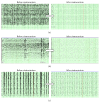The Benefit of Neuromuscular Blockade in Patients with Postanoxic Myoclonus Otherwise Obscuring Continuous Electroencephalography (CEEG)
- PMID: 28265468
- PMCID: PMC5317108
- DOI: 10.1155/2017/2504058
The Benefit of Neuromuscular Blockade in Patients with Postanoxic Myoclonus Otherwise Obscuring Continuous Electroencephalography (CEEG)
Abstract
Introduction. Myoclonus status epilepticus is independently associated with poor outcome in coma patients after cardiac arrest. Determining if myoclonus is of cortical origin on continuous electroencephalography (CEEG) can be difficult secondary to the muscle artifact obscuring the underlying CEEG. The use of a neuromuscular blocker can be useful in these cases. Methods. Retrospective review of CEEG in patients with postanoxic myoclonus who received cisatracurium while being monitored. Results. Twelve patients (mean age: 53.3 years; 58.3% male) met inclusion criteria of clinical postanoxic myoclonus. The initial CEEG patterns immediately prior to neuromuscular blockade showed myoclonic artifact with continuous slowing (50%), burst suppression with myoclonic artifact (41.7%), and continuous myogenic artifact obscuring CEEG (8.3%). After intravenous administration of cisatracurium (0.1 mg-2 mg), reduction in artifact improved quality of CEEG recordings in 9/12 (75%), revealing previously unrecognized patterns: continuous EEG seizures (33.3%), lateralizing slowing (16.7%), burst suppression (16.7%), generalized periodic discharges (8.3%), and, in the patient who had an initially uninterpretable CEEG from myogenic artifact, continuous slowing. Conclusion. Short-acting neuromuscular blockade is useful in determining background cerebral activity on CEEG otherwise partially or completely obscured by muscle artifact in patients with postanoxic myoclonus. Fully understanding background cerebral activity is important in prognostication and treatment, particularly when there are underlying EEG seizures.
Conflict of interest statement
The authors declare that they have no competing interests.
Figures


Similar articles
-
Accuracy of Limited-Montage Electroencephalography in Monitoring Postanoxic Comatose Patients.Clin EEG Neurosci. 2017 Nov;48(6):422-427. doi: 10.1177/1550059417715389. Epub 2017 Jun 22. Clin EEG Neurosci. 2017. PMID: 28641453 Free PMC article.
-
Combination of initial neurologic examination and continuous EEG to predict survival after cardiac arrest.Resuscitation. 2015 Sep;94:73-9. doi: 10.1016/j.resuscitation.2015.06.016. Epub 2015 Jul 8. Resuscitation. 2015. PMID: 26164682
-
Preliminary experience with point-of-care EEG in post-cardiac arrest patients.Resuscitation. 2019 Feb;135:98-102. doi: 10.1016/j.resuscitation.2018.12.022. Epub 2018 Dec 31. Resuscitation. 2019. PMID: 30605711 Free PMC article.
-
Continuous electroencephalogram monitoring in the intensive care unit.Anesth Analg. 2009 Aug;109(2):506-23. doi: 10.1213/ane.0b013e3181a9d8b5. Anesth Analg. 2009. PMID: 19608827 Review.
-
Continuous EEG monitoring: is it ready for prime time?Curr Opin Crit Care. 2009 Apr;15(2):99-109. doi: 10.1097/MCC.0b013e3283294947. Curr Opin Crit Care. 2009. PMID: 19578320 Review.
Cited by
-
Neuromuscular Blocking Agents and Reversal Agents Usage, and Neuromuscular Blockade Monitoring in the Intensive Care Unit - Review Article.Int J Gen Med. 2025 Jul 4;18:3651-3688. doi: 10.2147/IJGM.S524089. eCollection 2025. Int J Gen Med. 2025. PMID: 40636288 Free PMC article. Review.
-
Quantitative artifact reduction and pharmacologic paralysis improve detection of EEG epileptiform activity in critically ill patients.Clin Neurophysiol. 2023 Jan;145:89-97. doi: 10.1016/j.clinph.2022.11.007. Epub 2022 Nov 18. Clin Neurophysiol. 2023. PMID: 36462473 Free PMC article.
References
-
- Safar P. Cerebral resuscitation after cardiac arrest: a review. Circulation. 1986;74(6):138–152. - PubMed
-
- Wijdicks E. F. M., Hijdra A., Young G. B., Bassetti C. L., Wiebe S. Practice parameter: Prediction of outcome in comatose survivors after cardiopulmonary resuscitation (an evidence-based review). Report of the Quality Standards Subcommittee of the American Academy of Neurology. Neurology. 2006;67(2):203–210. doi: 10.1212/01.wnl.0000227183.21314.cd. - DOI - PubMed
LinkOut - more resources
Full Text Sources
Other Literature Sources
Miscellaneous

